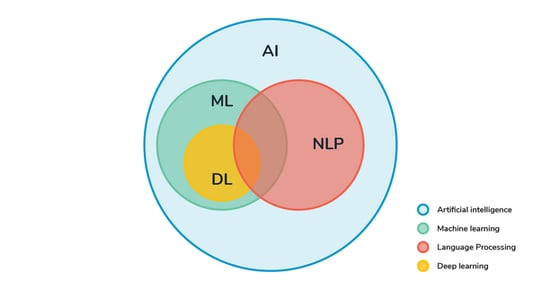Currently, technology has achieved great advances, we’re at a point where machines are now able to execute tasks we once thought only humans could do. For example, for a computer to interpret human speech would have been considered science fiction 20 years ago, but today, it’s a reality. Voice technology is now present in our daily routines. By solely using our voice, we can send commands to our mobile phone or control the devices in a “smart home.”
Today, phones have applications such as Alexa, Siri, Bixie, among others, that make it easy to add activities to a calendar or search for a contact by voice. All these applications use natural language processing and machine learning.
What is Natural Language Processing?
Natural language processing (NLP) is the interpretation of human language by a machine.
All languages have grammatical and semantic rules, however, exceptions exist. The same word in the same language can have a completely different meaning in different countries as well as in different contexts. Therefore, if it’s complicated for a person who speaks English, for example, to understand Spanish, then it’s complicated for a machine as well. This is where machine learning comes into play as a tool that helps to solve this particular problem.
Machine learning is a process that extracts knowledge from data. By relying on machine learning, it’s possible to improve NLP’s performance.
As we can see in Figure.1, NLP and machine learning are part of artificial intelligence and both subsets share techniques, algorithms, and knowledge.

Figure 1. AthenaTech LLC, 2019. AI, Machine Learning (ML), and Natural Language Processing (NLP). Taken from:: https://athenatech.tech/f/ai-machine-learning-ml-and-natural-language-processing-nlp
NLP: Fields of Use
At present, there are different fields in which NLP can be used. Among these we find:
- Translation: is the search for the most adequate way to express a phrase or a word in a different language. The best example may be Google’s translator, a tool that has gradually improved with the passage of time. At the start, its performance was very deficient since it used Phrase-Based Machine Translation (PBMT). PBMT looks for similar phrases between different languages, which means it doesn’t always find phrases with the same meaning; since there are words in one language that don’t exist in another, it’s impossible to translate them correctly. At present, Google uses Google Neural Machine Translation (GNMT), which uses machine learning with NLP to look for different patterns in languages.
- Speech recognition: a machine’s ability to interpret a language’s phrases and words. This application of NLP can be found in mobile phones and smart homes. By simply saying ‘call John’, the device recognizes what the phrase means and automatically calls John. Popular examples of this are Alexa or Siri.
- Sentiment analysis: identifies the implicit emotional tone in a phrase. For example, if a text announces the fall of stocks in the stock market, the program can predict it is a negative text. On the other hand, if a text talks about a party and who is invited to attend, its meaning can be taken as positive.
- Question/answer systems: consists of the automatic answering of questions by a program. This application of NLP can be easily found in social media chats, calls, or tools such as Siri and IBM Watson.
- Automatic text summarization: when given a text, the program extracts its main ideas and produces a coherent summary. For example, if someone has to read Don Quixote, a program can extract the book’s main ideas.
- Chatbots: are programs that hold conversations with humans. For example, when someone needs to buy something from an online shop and has certain questions about the product, it’s probable the answers they receive are generated by a machine.
- Market intelligence: based on what a person has searched for on the internet, it searches for any related ads. A good example of market intelligence is when a person looks for a specific product and automatically, ads related to the product show up on social media.
- Automatic text classification: assigns tags to a text depending on its content and semantics. For example, when receiving an email, this NLP application can tell if it’s spam based on its content.
- Automatic grammar checking: the computer recognizes different grammar or spelling mistakes in a text depending on context.
Advantages and Disadvantages
The advantages of implementing NLP include:
- Less expensive: using a program is less costly than employing a person. A person can take two or three times longer than a machine to execute the tasks mentioned above.
- Faster customer service response times: normally, when NLP is applied, chatbot or call response times are very quick. Usually, call centers have limited staff, which restricts the number of calls that can be answered. By using NLP, a higher call volume can be handled which means client wait times are reduced.
- Easy to implement: in the past, in order to use NLP, arduous research had to take place regarding the language and many tasks had to be implemented manually. In many cases, when it came to translation, it was necessary to create a sort of dictionary that included words that could be literally translated into another language. Therefore, it took a long time to develop. But today, it is easy to find pre-trained machine learning models that facilitate different applications of NLP.
Disadvantages of NLP include:
- Training can take time: if it’s necessary to develop a model with a new set of data without using a pre-trained model, it can take weeks to achieve a good performance depending on the amount of data.
- It’s not 100% reliable: one of the disadvantages of machine learning is that it’s never 100% dependable. There’s the possibility of errors in its prediction and results.
Conclusion
Natural language processing based on machine learning can be used efficiently in multiple fields. In fact, over time, we’ve noted better results and capabilities today in comparison to when these two technologies were introduced.
KEY TAKEAWAYS
|
